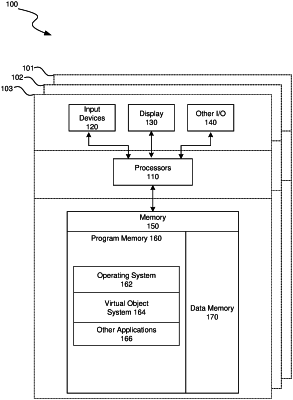| CPC G06T 19/20 (2013.01) [G06F 16/2291 (2019.01); G06T 19/006 (2013.01); G06T 2200/24 (2013.01); G06T 2219/2008 (2013.01)] | 20 Claims |

|
1. A non-transitory memory for storing a definition of a virtual object representing a user, for access by an application program executed on a processing system, the memory comprising:
a data structure stored in the memory, the data structure including information used by the application program and including:
a data component defining multiple attribute data elements for the user;
a controller component defining logic controlling how the virtual object responds to contexts, the contexts including one or more of: user actions, a determined world state, outputs from system services, outputs from other applications, or a combination thereof; and
a template component defining multiple view states with contextual breakpoints specifying transitions between the multiple view states,
wherein the each of the multiple view states defines A) which data elements, of the multiple attribute data elements, are displayed while that view state is active, and B) where the displayed data elements are displayed within a container defined for the virtual object,
wherein the multiple view states correspond to at least one icon state, at least one avatar state, and at least one live view state, and
wherein the contextual breakpoints specifying transitions between the multiple view states define a set of rules controlling which of the multiple view states is a current active view state.
|